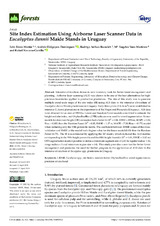Mostrar el registro sencillo del ítem
Site index estimation using airborne laser scanner data in Eucalyptus dunnii maide stands in Uruguay
| dc.contributor.author | Rizzo Martín, Iván Gabriel | |
| dc.contributor.author | Hirigoyen-Domínguez, Andrés | |
| dc.contributor.author | Arthus-Bacovich, Rodrigo | |
| dc.contributor.author | Varo-Martínez, Mª Ángeles | |
| dc.contributor.author | Navarro Cerrillo, Rafael M. | |
| dc.date.accessioned | 2023-05-25T10:16:13Z | |
| dc.date.available | 2023-05-25T10:16:13Z | |
| dc.date.issued | 2023 | |
| dc.identifier.issn | 1999-4907 | |
| dc.identifier.uri | http://hdl.handle.net/10396/25401 | |
| dc.description.abstract | Intensive silviculture demands new inventory tools for better forest management and planning. Airborne laser scanning (ALS) was shown to be one of the best alternatives for high-precision inventories applied to productive plantations. The aim of this study was to generate multiple stand-scale maps of the site index (SI) using ALS data in the intensive silviculture of Eucalyptus dunnii Maide plantations in Uruguay. Forty-three plots (314.16 m3) were established in intensive E. dunnii plantations in the departments of Río Negro and Paysandú (Uruguay). ALS data were obtained for an area of 1995 ha. Linear and Random Forest models were fitted to estimate the height and site index, and OrpheoToolBox (OTB) software was used for stand segmentation. Linear models for dominant height (DH) estimation had a better fit (R2 = 0.84, RMSE = 0.94 m, MAPE = 0.04, Bias = 0.002) than the Random Forest (R2 = 0.85, RMSE = 1.27 m, MAPE = 7.20, Bias=−0.173) model when including only the 99th percentile metric. The coefficient between RMSE values of the cross-validation and RMSE of the model had a higher value for the linear model (0.93) than the Random Forest (0.75). The SI was estimated by applying the RF model, which included the ALS metrics corresponding to the 99th height percentile and the 80th height bicentile (R2 = 0.65; RMSE = 1.62 m). OTB segmentation made it possible to define a minimum segment size of 2.03 ha (spatial radius = 30, range radius = 1 and minimum region size = 64). This study provides a new tool for better forest management and promotes the need for further progress in the application of ALS data in the intensive silviculture of Eucalyptus spp. plantations in Uruguay. | en |
| dc.format.mimetype | application/pdf | es_ES |
| dc.language.iso | eng | es_ES |
| dc.publisher | MDPI | es_ES |
| dc.rights | https://creativecommons.org/licenses/by/4.0/ | es_ES |
| dc.source | Forests, 14(5), 933 (2023) | es_ES |
| dc.subject | LiDAR | en |
| dc.subject | Eucaliptus spp. | en |
| dc.subject | Site Index | en |
| dc.subject | Random forest | en |
| dc.subject | OrpheoToolBox | en |
| dc.subject | Stand segmentation | en |
| dc.subject | Precision silvicultural | en |
| dc.title | Site index estimation using airborne laser scanner data in Eucalyptus dunnii maide stands in Uruguay | en |
| dc.type | info:eu-repo/semantics/article | es_ES |
| dc.relation.publisherversion | https://doi.org/10.3390/f14050933 | es_ES |
| dc.rights.accessRights | info:eu-repo/semantics/openAccess | es_ES |

